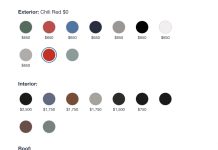At last, almost one year after the $50 hulk was hauled into the garage, the ’75 Kawasaki S1C “triple” is fully armed and operational.(For the “before” pics, see here.)
If you’ve been following this series, you’ll recall that in the last installment, I mentioned I was done except for the pipes – a set of high-performance chambered pipes to replace the (clogged, rusted-out) originals. I bought these from Higgspeed Performance in Britain. Higgspeed specializes in old two-strokes, Kaws and others – and supplied me with a set of absolutely gorgeous pipes to complete my restoration. Of course, these are not stock, but they are in keeping with the spirit of ’75 – when installing chambered pipes (Dencos especially) was the first thing many new triple owners did to their bikes. The factory pipes were notoriously heavy and also restrictive, so by adding a set of Dencos (or similar) you got the two-fer of reduced weight and more performance out of bikes that already ran like raped apes right off the showroom floor.
If you don’t know triple two-strokes, know this: A given two-stroke engine will produce about twice the output of a four-stroke the same size. So, a 250 cc unit like mine – which puts out about 30 hp, stock – is about as powerful as a typical 450-500 cc four-stroke.
And much, much more obnoxious.
The brimstone crackle and spitting that emanates from the S1’s triple exhaust pipes is like Satan’s own mood organ. Sulfurous smells of internal combustion accompany the racket. A cloud of bluish haze envelops you. Even at idle, the mean little SOB makes more noise than any of my other bikes – all my others bikes combined. Twist your wrist and the weedwhacker fury rises to a ferocious pitch, each pipe intemittently pulsing grossly uncontrolled exhaust so freely the sight of it would give Al Gore a stroke.
Now, to do some wheelies in front of his house… .
With the Higgspeed chambered pipes came new main jets – number 80s vs. the stock 75s. This is important. Gotta make sure the fuel flows copiously so as not to risk a lean-out, the one thing that will kill a two-stroke even faster than the EPA.
Speaking of which: Right now, as you’ll see in the pictures, I have aftermarket individual “pod” air cleaners on the carburetors. This is temporary. I am restoring the stock air box and plan to install it by next weekend. It will take some work – and some hunting. Original air cleaner elements are not easy to find and the rubber boots that connect the carbs to the steel air box needed some TLC. So, why not keep the pods? The truth, apparently, is that these old triples tend to run better – read, less erratically and less prone to holing a piston because of a lean-out condition – with the factory air box in place. Plus, I’m lucky enough to have all the parts – often, these got lost over the years – and I figure it will make the bike more like it was, circa ’75.
So, except for the Higgspeed pipes, the bike is restored to as it was. That includes the old-timey points ignition – three points, three condensors and three individual timing markers to line up. The triple is basically three singles riding a common crank. Ditto the carbs, which have to be individually adjusted – then synced to work together. In addition to the throttle slides, there is also a cold start plunger on each carb, connected (eventually) to a common cable that leads to a switch on the left handlebar. It’s not a choke, properly speaking, but it serves the same purpose. Making the adjustments is actually pretty easy. The factory Kaw manual is very helpful here.
But there was one area where it was not helpful at all – and it’s why it took me a few extra unanticipated weeks to get to this final installment – and get the bike running.
Everything (except the pipes) was done about a month ago. Then the pipes came. I immediately installed them, lusting to hear the resurrected sounds of my little stinker. Fuel tap on, starter plunger engaged… kick…. freewheel!
Puzzled, I fiddled. I removed the side cover to see what I could see. Through a window in the case I saw the starter gear on its shaft. As the kicker lever is rotated, this gear moves forward, meshing with the big gear on the clutch basket, thus rotating the assembly and causing the bike to start. Only my gear was not quite meshing. It seemed to want to, but didn’t get there all the way. I could get a partial engagement, if I rotated the mechanism by hand, carefully. Of course, this wasn’t going to work. The S series bikes do not have electric start, so if you want to start the bike, you need a working kicker. And the only way to get at the kicker to fix it is to pull the engine and split the cases. 
So, off came the newly installed pipes – and everything else, too. Back on the bench, the cases open once more, I tried to figure out what I’d missed. Everything looked right. The kicker shaft was seated correctly, the tang in the lower case and the tensioner spring “L” tab secured. I consulted the factory shop manual. No help. So I consulted my friend Graves – ace mechanic and old bike freak like me. We took the entire kicker assembly apart and closely examined every piece of it. All seemed in order – but I was not confident enough to put it all back together (again) and then have to take it all apart (again). Cleaning Kawsaki-Bond off the case surfaces is not my idea of a party.
Then, I did some board surfing. And I found my needle in a haystack. Though the Kaw factory manual does not mention it, the circlip-like ring that rides on the kicker shaft – and which helps to push the gear to mesh with the clutch basket gear – sometimes loses tension. In which case, the gear won’t mesh positively (or at all). The fix is to gently squeeze the thing so as to restore the tension. El fixo! The kicker gear meshed properly – and now I could put the thing back together (and back into the bike) with confidence.
An hour or so later and the Moment had arrived. I ought to mention here that I pre-mixed the gas with two-stroke oil, even though the S series bikes have an oil injection system (Superlube). Reason? A fail-safe. It is always possible that the factory oil pump may not work – or not work right – upon start-up. If that happens, you might very well melt/seize/ruin your just-rebuilt engine. By feeding it pre-mix, you eliminate this concern. The bike will smoke even more heavily than it otherwise would, of course – but isn’t that part of the fun? 
The main thing is you won’t have to worry about a catastrophic failure – and you can safely check the function of the Superlube oil pump with the engine running. This is done by visually confirming oil delivery through the three clear plastic feed tubes that come off the pump and run to each of the bike’s three cylinders. By manually holding open the pump lever arm, you can bleed out any trapped air. Once all signs of air bubbles are gone you can feel confident that the engine is receiving the oil it needs. However, there are some who still like to add some oil to their gas – just in case.
The Superlube system does not have any warning mechanism built in. So if for whatever reason it stops working while the engine is running, you may not have any idea until major damage has already occurred. By mixing some two-stroke oil with the gas, you eliminate that potential problem. Just be aware the bike will smoke more (hooray!) and you’ll probably need to clean/change plugs even more frequently. For me, it’s not an issue – because this bike is just for fun – not an everyday rider or long-trip machine.
I still need to get my seat recovered – it looks ok in the pictures, but it’s covertly electric-taped in several places to hide the tears. I also need to get the neutral switch light adjusted (works sometimes) and get the original air box presentable, functional – and reinstalled. But other than these few details, the bike’s complete at last. It’s been – well, I won’t say entirely fun. The kicker issue damn near drove me to tears. But overall, I had a good time.
And I expect to have an even better time howling around the neighborhood on this angry little demon!
Throw it in the Woods?













Thanks Dom. Btw, there’s one similar bike well ,,,,S1F to be exact …on sale here in my country, for $1400…crazy : )
Hi Oscar,
Have you got a link/pics for that S1?
Eric, how tall is the guy in orange shirt?
That’s Eric (6’3″).
That’s me on the bike, Oscar. I was heavier then (227) but am still the same height ( 6ft 3).
Beautiful rebuild. I’d love to have that bike!
On a related topic, do you think we’ll see two-stroke engines make a comeback in street bikes, given that they’ve whipped the dirty emissions problem? I’d give one of my testicles for a light weight motorcycle, driven by a 400cc two-stroke engine.
Thanks, Alex!
If you like these things, the S series (S1, like mine – then the S2 and S3) are still very affordable – unlike the better-known H1 and H2. I got mine for literally $50. Granted, it needed a complete rebuild – but the bike was “all there” (all major parts, no major damage; engine still turned; i.e., not seized up, etc.). So, a good starting point. Meanwhile, it’s much harder to find an intact, “all there” H1 or H2 project bike – and running ones will costs you a small fortune.
Of course, a 500 or 750 will give you more power/performance, but otherwise, the S series is very similar in terms of layout, looks – and personality.
On two-strokes, generally: I know of no plans to bring them back as street bike engines. I’d like to see it happen, too. I appreciate a simpler, more compact (and high-powered) engine. But I think there are still issues with EPA compliance, among other obstacles.
But that doesn’t mean we can’t rebuild an old one ourselves!
Thanks for the info, Eric. I’ll keep your suggestions in mind as I browse ebay and cycletrader.
That’s a shame about the fact that there are no 2-stroke street bikes coming out this year. I had a 50cc two stroke mini-bike when I was a kid, looked a lot like the Honda Ruckus, and it was loud, smelly and fast as hell, screaming like a Banshee when you took off from a stop.
I’d like to see that again, because I subscribe to the Terminator mindset: every generation of bike should be lighter, faster, stronger and simpler to work on and reworking the heart of a bike with a 2-stroke is the next logical move.
Anyway, wring that blue devil’s neck while you can, and live damn it, live before joy is outlawed!
You bet!
PS: There’s also the Yamaha RD (and RZ) series…. the RDs are more conservative than the Kaw triples, but the RZs…. watch out!
Congrats, Eric! This looks like fun, and a good reward for the work you put into it.
I’ve got around $9k in my diesel Suburban conversion, I hope to be driving it soon! No doubt I’ll find some issues to address as soon as I get it running.
In my philosophy, you don’t really *own* a vehicle until you’ve pulled it apart and reassembled it to some degree.
“In my philosophy, you don’t really *own* a vehicle until you’ve pulled it apart and reassembled it to some degree.”
I agree with that!
Such a vehicle is yours, intimately. Nothing you just buy can ever be like that….
That is insane! Love it. I never had a dirtbike as a kid and almost dropped someone elses when riding as a kid, but that thing brings back memories. I bet it goes like stink. You did a better than factory job on it from what I can see.
Thanks, Henry!
I’m pretty happy with it. The bikes from that era – ’70s and early ’80s – exert an emotional pull on me. The outrageousness, the wild colors and shapes – the total absence of even a cursory nod toward “safety”… they are totems of a different time… and a different America!
Awesome job Eric! Between this and the cafe racer site someone here linked to the other day, I’ve gotta have another oil burner. Just ignore Mike_A. It’s true that cool-down lap seize up could occur with 2-stroke bikes running pre-mix only during hard downshifting. The oil injection systems on the street bikes were set up to meter on both throttle position or engine RPM. So if you pulled the oil bag and pump to reduce weight and ran premix only, you stood a very good chance of seizing the engine on hard downshifting (carb slides closed = no fuel = no lube). Street riders that were used to constant engine lubrication on 4-strokes could lock up a 2-stroke on premix pretty easily that way. I know; I did it at about 105 MPH one time on my RD350. My steering damper had gone dry (unbeknownst to me) and my bike went into a high speed wob at about 110. So I kicked it down hard, plumb forgetting that we’d removed the oil injection system. The engine locked up tighter’n a frog’s ass and I laid down about 70 ft. of rubber before I remembered I had a clutch (the bike was almost sideways at that point). It caused me to leave a pucker mark on the seat cushion I assure you! After the bike cooled off, I shot a little oil in the cylinders, kicked it over a few times and it fired right back up and ran fine. How lucky can you get? Anyway go smoke up the neighborhood one time for me! I hope to be rejoining the oil burner ranks myself again soon (I’m thinking H2 cafe racer).
See, this is exactly the kind of nonsense that tells me you two stroke guys aren’t wired right. It’s NOT normal for a motor to just decide it’s not going to turn anymore at triple digit speeds. It’s not. Really. Ask my buddy that been pitched off his RZ more times than he cares to remember.
Don’t go giving me that whole “what’s a tappet or you mean there’s a chain INSIDE the motor..?” routine either. I’ve heard it all from your little cult!
Two strokes are for outboard motors and lawn equipment as God intended.
Hey Mike_A, you forgot chainsaws… 😉
P.S. Whaddya’ mean 4-strokes don’t have reed valves?
Thanks – and, I will!
So I am looking at the photo and I think that’s way more smoke than it should have… Then reading the article it all makes sense. Congrats on getting it done.
That is awesome! Seriously though, next time, stay away from those mosquito killing death traps that seize on the cool down lap and pitch you into the stratosphere. I don’t want your articles to go away.
I’ll try!
Great work, Eric. Congratulations on the end product and your perseverance, sir.
Absolutely sick! We need a video of it in action now. I would love to see that thing smoking up the place. If I had one I’d add extra oil when around NoVa.
congrats, getting it back together and then having minor mechanical issues to fix can be extremely hair ripping frustrating but now you know some idiosyncracy about it that is far from common knowledge.
great build, i read you bought it for $50, if you are comfortable sharing it, how much did the restoration cost all-in?
Thanks!
The major expenses were:
Rebuilt crank (have to farm it out; requires machinist and tools and skills I lack). About $900.
Higgspeed chambered pipes (not essential, but money well-spent!) Another $900
Paint (I did the frame and small parts but had the tank and bodywork done by a professional).$1,300
Some NOS parts (turn signals, lenses, etc.)
The rest was just rebuilding the existing stuff and cosmetic detailing/restoration. My labor (free) and supplies (not very expensive).
So, in the neighborhood of $4,500 all told. I guess closer to $5,000 if you include the new tires and other things I’ve probably forgotten about.
I think I ended up with a bike that cost me less than it would have had I just went out and bought a similar condition machine. Not much less, probably – but roughly.